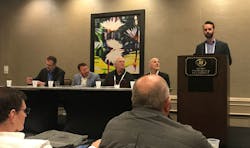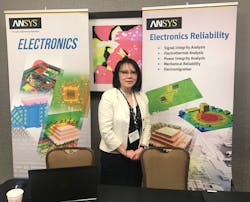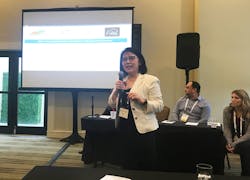A Recap of WAMICON 2019
Cocoa Beach, Florida played host to this year’s IEEE Wireless and Microwave Technology Conference (WAMICON), which convened April 8-9 at the Hilton Cocoa Beach Oceanfront hotel. This year’s event, which marked WAMICON’s 20th anniversary, featured several tutorials, a panel session, an exhibition, and much more.
Simulation software was a main emphasis of WAMICON 2019, evidenced by the panel session titled, “Emerging Simulation Technologies: Can today's EDA tools solve tomorrow's designer challenges?” Five participants made up the panel: Todd Cutler from Keysight Technologies, John Park from Cadence, John Dunn from AWR Group, National Instruments (NI), Theunis Beukman from Dassault Systèmes (provider of CST Studio Suite), and Matt Commens from ANSYS (Fig. 1).
1. The panel session consisted of five representatives from different simulation software providers.
Toward the end of the session, all of the panelists were given an opportunity to discuss a little bit of what they think lies ahead for simulation-based design. Theunis Beukman spoke first, explaining that multi-domain simulations already represent a challenge that will only increase in scope. Beukman also noted that “complex phased-array systems are a big challenge” before explaining the need for full co-simulations rather than just segregated solutions.
Matt Commens emphasized the importance of automation. “We get into the simulation business because it’s really interesting, it’s very technical, and there are a lot of physics,” he said. “We want to show everybody all the bells and whistles and all the different knobs they can turn. At some point, that’s just not good enough. We need to do a better job of making more of this automated. I often have a discussion with our developers and I say let’s just ask the user for information that they know—not information that we know.”
According to John Park, a big challenge will be to come up with a system-level solution. “Today, everybody can find tools for their own niche,” he explained. “In the future, with 5G and other technology, everything is coming together. You can’t just think about my filter, my chip, my package, etc. You have to think about the entire system. That changes the EDA tool dramatically from an integration level as well as a capacity level.”
John Dunn believes that the cloud is a game changer in the realm of simulation software—and that companies need to figure it all out. Dunn also spoke along the lines of what Matt Commens said regarding automation: “I think that as we do these problems, there has to be more automation of these setups for the average user while letting the expert be able to override them to get better performance. It’s a real challenge for us to do that.”
Lastly, one of the points mentioned by Todd Cutler is the importance of just simply letting engineers design. “Right now, engineers spend too much time messing around with their tools,” he said. “If the tool is working better, they spend more time designing and innovating rather than messing around.”
Cutler also served as the plenary speaker for WAMICON 2019—his presentation was titled “The Future of High-Frequency Design and Test.” He spoke about some of the inefficiencies with respect to workflows, with one point being that a “huge amount of time” is often spent correlating simulated results with test results. Cutler explained that one of the reasons why this occurs is because engineers use many different tools.
A consequence of using many different tools, according to Cutler, is that “it’s hard to get all of them to work together.” Specifically, a large percentage of design engineers use more than five design tools and a large percentage of test engineers use more than three test tools.
Furthermore, Cutler spoke about the interoperability challenges associated with data, explaining that “data is generally stored in different places in different formats—and it’s just not easy to share.” He then mentioned the cloud as a means for managing and storing data in a more efficient way.
Cutler also remarked that “most organizations have individual groups. There’s a design group, a test group if you’re going to qualify a design before it comes out, a manufacturing test group, etc.” He noted that different groups often operate separately from one another. However, a more unified approach must be considered, according to Cutler.
Specifically, Cutler said, “We believe that there’s a great opportunity to apply some of the technologies available to help unite this workflow and simplify the overall work. A big part of this is data sharing.” Cutler then brought up results from a survey, which revealed that sharing data across teams is the number one way to reduce time to market.
So, what approach should companies take in the future? Again, the answer lies in “a unified and coherent workflow,” according to Cutler. He then explained some of the principals behind achieving this “connected design and test” vision.
Tutorials, Exhibition, and More
As stated, WAMICON 2019 placed a heavy focus on simulation software. Tutorials were given by several representatives from simulation software providers, such as Matt Commens and John Dunn. In addition, Brian Rautio from Sonnet gave a tutorial, as well as Shu Li from Dassault Systèmes and Wilfredo Rivas-Torres from Keysight.
Among the many paper presentations was John Park’s “Challenges of designing heterogeneous (multi-PDK) packages.” Michael Knox from the New York University Tandon School of Engineering received the best paper award for his work titled “Simplified Tapped Delay Line Architecture for Active Cancellation in a 2x2 IBFD MIMO Transceiver (Fig. 2).”
2. Michael Knox’s paper titled, “Simplified Tapped Delay Line Architecture for Active Cancellation in a 2x2 IBFD MIMO Transceiver,” was recognized as the best paper of WAMICON 2019.
The exhibition featured displays from companies such as Keysight, Copper Mountain Technologies, ANSYS, Reactel, Mini-Circuits, Rohde & Schwarz, and Modelithics. Others included Sonnet, VIDA Products, and NSI-MI Technologies.
3. Keysight’s P9375A Streamline USB vector network analyzer, on display at the exhibition, operates to 26.5 GHz.
Among the products highlighted was Keysight’s P9375A Streamline USB vector network analyzer (VNA) (Fig. 3). Also featured was the latest technology from ANSYS, such as 3D components and other recent innovations (Fig. 4).
4. Here, Charlotte Blair poses at ANSYS’s booth. The company showcased technology such as 3D components.
Speaking of ANSYS, the company’s own Charlotte Blair was one of the speakers at the Joint Young Professionals and Women in Microwaves reception, which capped off the conference (Fig. 5). The speakers were able to share their own personal stories, as well as offer career advice. One interesting story was told by Laura Levesque of Modelithics. She spoke about how she started out in avionics engineering and then entered the RF/microwave industry by first working as a technician at Modelithics, before ultimately moving on to her current role with the company.
5. Charlotte Blair also spoke at the Joint Young Professionals and Women in Microwaves reception.
The General Chair of WAMICON 2019 was Hjalti Sigmarsson from the University of Oklahoma. Quenton Bonds from the Goddard Space Flight Center will serve as the General Chair of WAMICON 2020. Bonds has high hopes for next year’s conference; one of the goals is to double the attendance. If you’re reading this, you can help him achieve that feat by attending WAMICON 2020, which will take place on Florida’s Gulf Coast.






